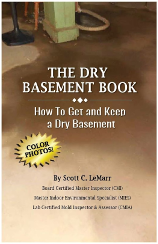Orphaned Chimney
We just had an inspection and the inspector called out an orphaned chimney but nobody can seem to explain this to us
Dennis
Dear Dennis,
This happens all too often…both the explanation and the orphaned chimney. An Orphaned Chimney happens when the original chimney

to the house was sized for an older furnace and a water heater. Now the new 90% or greater furnace vents through the side of the house with PVC pipe and leaves the water heater alone in an oversized chimney. Notice that most water heaters have an exhaust pipe of about 3” in diameter, and the chimney is likely 10” x 12” or larger. The water heater exhaust does not have enough buoyant exhaust fumes when the weather is cold outside. The cold air fights with the warm air rising out of the chimney creating a tremendous amount of moisture, many gallons of water can condense every week, saturating the masonry and adjacent plaster. In the cold part of the chimney, the condensate goes through freeze/thaw cycles, which can damage the tiles. In addition the cold air can overcome the warm air and force the water heater exhaust down the chimney to the point of back drafting allowing combustion gases (and carbon monoxide) into the living area of the home.
The fix is often simple but there are options, the options would be based on how old the water heater is, what condition your appliance chimney is in, what kind of shape your chimney flashing is in, and what kind of shape the roof is in. If the chimney and flashing are in good shape and the gas water heater is newer then lining the chimney may be your best option. Basically there is an aluminum liner (3” flexible pipe UL listed for the application) that goes from the top of the chimney to the water heater and it is 3” in diameter. On the top of the chimney there is a cap that goes on the 3” liner and a cover that closes up the larger hole left around the liner so now the chimney is sealed from the elements and is now 3” diameter all the way to the water heater. In the basement, the installer just reaches into the chimney and pulls the liner through while attaching it to the water heater exhaust pipe and you are done. For the seller this may be the cheapest route.
Out of the box thinking, If the chimney is not in good shape and chimney work will be required an option is to knock down the chimney at the attic level and roof over where the chimney used to be. Keep in mind the chimney is the most common roof penetration to leak. If we can get rid of this penetration there is less likely water intrusion into your house and potential mold. If you are going to have to put on a new roof than this is an even better option. Once the roof has been sealed a power vent gas water heater or an electric water heater can be installed. Newer electric water heaters are by far more efficient than they ever were and are cheaper than the power vent even with an electrician involved. So there are some alternatives.
Some HVAC technicians will do a chimney liner and so will most chimney/fireplace companies.






